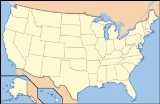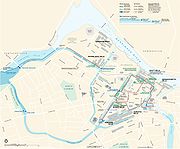
Lowell National Historical Park
Encyclopedia

National Historical Park
National Historic Sites are protected areas of national historic significance in the United States. A National Historic Site usually contains a single historical feature directly associated with its subject...
of the United States
United States
The United States of America is a federal constitutional republic comprising fifty states and a federal district...
located in Lowell, Massachusetts
Lowell, Massachusetts
Lowell is a city in Middlesex County, Massachusetts, USA. According to the 2010 census, the city's population was 106,519. It is the fourth largest city in the state. Lowell and Cambridge are the county seats of Middlesex County...
. Established in 1978 a few years after Lowell Heritage State Park
Lowell Heritage State Park
Lowell Heritage State Park is located in Lowell, Massachusetts. The State Park was established in the mid-1970s as a precursor to Lowell National Historical Park with the purpose of preserving the city's seminal role in the American Industrial Revolution...
, it is operated by the National Park Service
National Park Service
The National Park Service is the U.S. federal agency that manages all national parks, many national monuments, and other conservation and historical properties with various title designations...
and comprises a group of different sites in and around the city of Lowell related to the era of textile
Textile
A textile or cloth is a flexible woven material consisting of a network of natural or artificial fibres often referred to as thread or yarn. Yarn is produced by spinning raw fibres of wool, flax, cotton, or other material to produce long strands...
manufacturing in the city during the Industrial Revolution
Industrial Revolution
The Industrial Revolution was a period from the 18th to the 19th century where major changes in agriculture, manufacturing, mining, transportation, and technology had a profound effect on the social, economic and cultural conditions of the times...
.
History
- See the History of Lowell, MassachusettsHistory of Lowell, MassachusettsThe History of Lowell is closely tied to its location along the Pawtucket Falls of the Merrimack River, from being an important fishing ground for the Pennacook tribe to providing water power for the factories that formed the basis of the city's economy for a century...
article for a detailed history of the city
First settles by Europeans in the 17th century, East Chelmsford (later re-named Lowell in honor of the founders' deceased business partner) became an important manufacturing center along the Merrimack River
Merrimack River
The Merrimack River is a river in the northeastern United States. It rises at the confluence of the Pemigewasset and Winnipesaukee rivers in Franklin, New Hampshire, flows southward into Massachusetts, and then flows northeast until it empties into the Atlantic Ocean at Newburyport...
in the early 1820s. It was seen as an attractive site for the construction of a planned industrial city, with the Middlesex Canal
Middlesex Canal
The Middlesex Canal was a 27-mile barge canal connecting the Merrimack River with the port of Boston. When operational it was 30 feet wide, and 3 feet deep, with 20 locks, each 80 feet long and between 10 and 11 feet wide...
(completed in 1803) linking the Merrimack to the Charles River
Charles River
The Charles River is an long river that flows in an overall northeasterly direction in eastern Massachusetts, USA. From its source in Hopkinton, the river travels through 22 cities and towns until reaching the Atlantic Ocean at Boston...
, which flows through Boston, and with the powerful 32' Pawtucket Falls. The already existent Pawtucket Canal
Pawtucket Canal
Completed in 1796, the Pawtucket Canal was originally built as a transportation canal to circumvent the Pawtucket Falls of the Merrimack River in East Chelmsford, Massachusetts. In the early 1820s it became a major component of the Lowell power canal system...
, designed for transportation around the Pawtucket Falls
Pawtucket Falls (Massachusetts)
Pawtucket Falls is the name of a waterfall on the Merrimack River at Lowell, Massachusetts. The waterfall and rapids below it drop a total of 32 feet in a little under a mile., and was an important fishing ground for the Pennacook Indians in pre-colonial times.This location was used as a benchmark...
on the Merrimack, became the feeder canal for a 5.6-mile long system of power canals based around the falls. Unlike many other mill towns, however, Lowell's manufacturing facitilities were built based on a planned community design. Specifically Lowell was planned as reaction to the mill communities in Great Britain
United Kingdom
The United Kingdom of Great Britain and Northern IrelandIn the United Kingdom and Dependencies, other languages have been officially recognised as legitimate autochthonous languages under the European Charter for Regional or Minority Languages...
, which were perceived as cramped and inhumane. Initially the factories of Lowell were built with ample green space and accompanying clean dormitories, in a style that anticipated such later architectural
Architecture
Architecture is both the process and product of planning, designing and construction. Architectural works, in the material form of buildings, are often perceived as cultural and political symbols and as works of art...
trends as the City Beautiful movement
City Beautiful movement
The City Beautiful Movement was a reform philosophy concerning North American architecture and urban planning that flourished during the 1890s and 1900s with the intent of using beautification and monumental grandeur in cities. The movement, which was originally associated mainly with Chicago,...
in the 1890s. Lowell attracted both immigrants from abroad and migrants from within New England
New England
New England is a region in the northeastern corner of the United States consisting of the six states of Maine, New Hampshire, Vermont, Massachusetts, Rhode Island, and Connecticut...
and Quebec
Quebec
Quebec or is a province in east-central Canada. It is the only Canadian province with a predominantly French-speaking population and the only one whose sole official language is French at the provincial level....
(including a large proportion of young women) who lived in the dormitories and worked in the mills.
The textile industry in New England experienced a sharp decline after World War II and by the 1960s, many of the Lowell's textile mill buildings were abandoned. In the late 1960s and early 1970s, several important forces came together from which emerged the Lowell National Historical Park. Congressman F. Bradford Morse assisted in the city's selection for "Model Cities" status; Brendan Fleming, UML, Math Department, faculty member, after his election to the Lowell City Council proposed the first Historic District “The Mill and Canal District” which was approved in 1972; Gordon Marker, Executive Director of Model Cities and an urban planner, was instrumental in designing the concept for an Urban Park based on Historic Preservation and Economic Revitalization; Patrick Mogan, Education Administrator and later Superintendent of Schools, was primarily interested in Lowell’s children and strongly advocated the preservation and sharing of their cultural experiences; and the Lowell Historical Society which opened the Lowell Museum in 1976. Together these circles of interest became a collaborating force led by United States Senator and Lowell native Paul Tsongas
Paul Tsongas
Paul Efthemios Tsongas was a United States Senator from Massachusetts from 1979 to 1985. He was an unsuccessful candidate for the Democratic nomination in the 1992 presidential election. He previously served as a U.S...
to enact legislation for a national park. In 1978, the United States Congress
United States Congress
The United States Congress is the bicameral legislature of the federal government of the United States, consisting of the Senate and the House of Representatives. The Congress meets in the United States Capitol in Washington, D.C....
established the Lowell National Historical Park and the Lowell Historic Preservation Commission.
Park Information
Among the notable features of the park are:- Boott Cotton Mill and Museum
- The Francis Gate
- Pawtucket Dam and Gatehouse
- Suffolk Mill Turbine and Powerhouse
- Kirk Street Agents House
- Mill Girls and Immigrants Boardinghouse
- The Lowell Canal System
- Swamp Locks, Lower Locks, Guard Locks
- Merrimack River and Northern Canal Walkway
The park includes a Visitor Center, as well as many restored and unrestored sites from the 19th century. The Visitor Center provides a free self-guided tour of the history of Lowell, including display exhibits such as the patent
Patent
A patent is a form of intellectual property. It consists of a set of exclusive rights granted by a sovereign state to an inventor or their assignee for a limited period of time in exchange for the public disclosure of an invention....
model of a loom
Loom
A loom is a device used to weave cloth. The basic purpose of any loom is to hold the warp threads under tension to facilitate the interweaving of the weft threads...
by local inventor S. Thomas.
A footpath along the Merrimack Canal
Merrimack Canal
The Merrimack Canal is a power canal in Lowell, Massachusetts. The canal, dug in the 1820s, begins at the Pawtucket Canal just above Swamp Locks, and empties into the Merrimack River near the Boott Cotton Mills...
from the Visitor's Center is lined with plaques describing the importance of various existing and former sites along the canal. The Boott Mills
Boott Mills
The Boott Mills in Lowell, Massachusetts are an early American cotton mill, parts of which date to 1835. Their namesake is Kirk Boott, one of the early mill leaders in Lowell. Today, the Boott Mills complex is the most intact in Lowell....
along the Merrimack river, on the Eastern Canal, is the most fully restored manufacturing site in the district, and one of the oldest. The Boott Mill provides a walk-through museum with living recreations of the textile manufacturing process in the 19th century. The walking tour includes a detour to a memorial to local author Jack Kerouac
Jack Kerouac
Jean-Louis "Jack" Lebris de Kerouac was an American novelist and poet. He is considered a literary iconoclast and, alongside William S. Burroughs and Allen Ginsberg, a pioneer of the Beat Generation. Kerouac is recognized for his spontaneous method of writing, covering topics such as Catholic...
, who described the mid-20th century declined state of Lowell in several of his books. A walkway along the river leads to several additional unrestored mill sites, providing views of restored and unrestored canal raceways
Mill race
A mill race, raceway or mill lade is the current or channel of a stream, especially one for conducting water to or from a water wheel or other device for utilizing its energy...
once used by the mills. Additionally, the park includes the Patrick J Mogan Cultural Center, which focuses on the lives of Lowell's many generations of immigrants. Other exhibits include a working streetcar line, canal boat tours exploring some of the city's gatehouse
Gatehouse (waterworks)
A gatehouse, gate house, or valve house for a dam is a structure housing sluice gates, valves, or pumps . Many gatehouses are strictly utilitarian, but especially in the nineteenth century, some were very elaborate....
s and locks, and the River Transformed / Suffolk Mill Turbine Exhibit, which shows how water power, namely the Francis Turbine
Francis turbine
The Francis turbine is a type of water turbine that was developed by James B. Francis in Lowell, Massachusetts. It is an inward-flow reaction turbine that combines radial and axial flow concepts....
, was once used to run Lowell's textile factories.
External links
- Lowell National Historical Park website
- Lowell National Historical Park 2009 Annual Report
- Heritage Preservation and Development White Paper: A 30 Year Assessment of Lowell National Historical Park
- Presentation of Lowell Stories White Paper: A 30 Year Assessment of Interpretation and Education at Lowell National Historical Park
- Building America's Industrial Revolution: The Boott Cotton Mills of Lowell, Massachusetts, a National Park Service Teaching with Historic Places (TwHP) lesson plan

